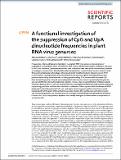A functional investigation of the suppression of CpG and UpA dinucleotide frequencies in plant RNA virus genomes
Abstract
Frequencies of CpG and UpA dinucleotides in most plant RNA virus genomes show degrees of suppression comparable to those of vertebrate RNA viruses. While pathways that target CpG and UpAs in HIV-1 and echovirus 7 genomes and restrict their replication have been partly characterised, whether an analogous process drives dinucleotide underrepresentation in plant viruses remains undetermined. We examined replication phenotypes of compositionally modified mutants of potato virus Y (PVY) in which CpG or UpA frequencies were maximised in non-structural genes (including helicase and polymerase encoding domains) while retaining protein coding. PYV mutants with increased CpG dinucleotide frequencies showed a dose-dependent reduction in systemic spread and pathogenicity and up to 1000-fold attenuated replication kinetics in distal sites on agroinfiltration of tobacco plants (Nicotiana benthamiana). Even more extraordinarily, comparably modified UpA-high mutants displayed no pathology and over a million-fold reduction in replication. Tobacco plants with knockdown of RDP6 displayed similar attenuation of CpG- and UpA-high mutants suggesting that restriction occurred independently of the plant siRNA antiviral responses. Despite the evolutionary gulf between plant and vertebrate genomes and encoded antiviral strategies, these findings point towards the existence of novel virus restriction pathways in plants functionally analogous to innate defence components in vertebrate cells.
Citation
Ibrahim , A , Fros , J , Bertran , A , Sechan , F , Odon , V , Torrance , L , Kormelink , R & Simmonds , P 2019 , ' A functional investigation of the suppression of CpG and UpA dinucleotide frequencies in plant RNA virus genomes ' , Scientific Reports , vol. 9 , 18359 . https://doi.org/10.1038/s41598-019-54853-0
Publication
Scientific Reports
Status
Peer reviewed
ISSN
2045-2322Type
Journal article
Collections
Items in the St Andrews Research Repository are protected by copyright, with all rights reserved, unless otherwise indicated.

